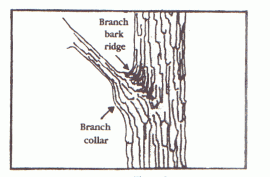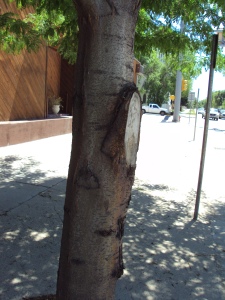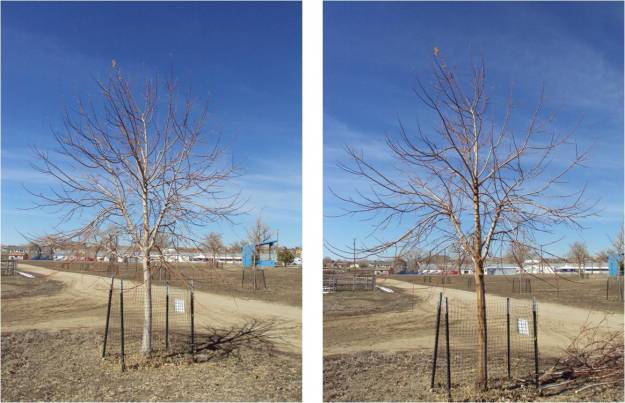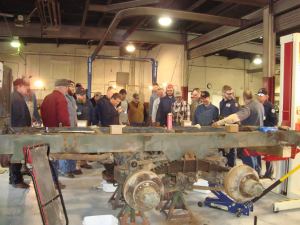
Trees such as this Siberian elm were decimated in many WY communities as the result of heavy wet snows.
This fall brought several early snowstorms that did considerable damage to trees around the state. Lander, Riverton, Casper, Buffalo, Sheridan, Gillette and others saw snowstorm totals range from 8 -18 inches of heavy wet snow. With trees in full leaf, the tree canopies held an immense amount of snow and many failed as a result. Municipal, county, private and utility crews spent days clearing streets, alleys and utility lines from fallen trees and broken limbs. Homeowners also cleared their properties of tree debris and many hired professional arborists to assist.
Now that most of the limbs have been picked-up and hauled away, attention should be focused on the trees that still remain. Where injuries occurred, trees must be repaired to prevent further damage. Broken branches or stubs should be pruned back to a lateral branch or to the trunk. When pruning back to a lateral branch, the lateral must be at least 1/3 the diameter of the branch being removed or the  lateral will not be able to support the larger branch and will likely die-back. Similarly, if the main trunk is broken, the broken portions should be pruned out, back to a lateral limb at least 1/3 the diameter of the trunk.
lateral will not be able to support the larger branch and will likely die-back. Similarly, if the main trunk is broken, the broken portions should be pruned out, back to a lateral limb at least 1/3 the diameter of the trunk.
When making a cut to remove a heavy limb, the 3-cut method should be used to prevent the weight of the limb from tearing or stripping off the bark down the trunk and exposing the inner portions of the trunk.
- Cut part way through the branch from beneath at a point about a foot from the trunk.
- Make a second cut on the top of the branch, several inches out from the first cut. This should allow the limb to break off from its own weight and fall to the ground.
- Complete the job by making a final cut next to the trunk, just outside the branch collar,
 with the lower edge farther away from the trunk than at the top. Do not make the final cut flush against a limb or the trunk. Flush cuts reduce the tree’s ability to seal off the wound and weaken its natural defenses against disease and decay.
with the lower edge farther away from the trunk than at the top. Do not make the final cut flush against a limb or the trunk. Flush cuts reduce the tree’s ability to seal off the wound and weaken its natural defenses against disease and decay.
In large storms it’s common for branches to break apart from the trunk and tear down into  the trunk, creating jagged ugly wounds. However, this type of wound can be repaired if the wound is less than half the diameter of the trunk. Remove the branch first then carefully use a chisel or sharp knife to smooth ragged edges of dead or dying bark by removing the bark back to the point at which it is attached to the tree. Try not to expose any more inner bark than is necessary and keep the wound as narrow as possible to hasten wound closing. Do not apply a wound dressing or tree paint to wounds or pruning cuts. These compounds have actually been found to slow wound closure and promote decay.
the trunk, creating jagged ugly wounds. However, this type of wound can be repaired if the wound is less than half the diameter of the trunk. Remove the branch first then carefully use a chisel or sharp knife to smooth ragged edges of dead or dying bark by removing the bark back to the point at which it is attached to the tree. Try not to expose any more inner bark than is necessary and keep the wound as narrow as possible to hasten wound closing. Do not apply a wound dressing or tree paint to wounds or pruning cuts. These compounds have actually been found to slow wound closure and promote decay.

The branch bark collar was removed when this flush cut was done. This has prevented callus tissue from sealing off the wound, leading to decay.
If heavy damage has been done to your tree, you have the difficult choice of whether to cut the tree down or save it. Many factors can weigh into your decision, however if your tree is large, an arborist who can better evaluate the structural integrity of the tree should be consulted to give you a full picture of the tree’s health and structural defects. Arborists with the proper equipment and know-how can remove large limbs and/or large trees in a much safer manner than most homeowners can. Make sure you hire an ISA certified arborist who is fully insured for property damage, personal liability and workers compensation. It is also wise to get more than one estimate when possible. In case of tree removals, have a clear understanding about who removes the limbs and debris from the property and whether or not the price includes stump removal and clean-up.
If your tree is small, you may be able to evaluate it yourself and take the necessary actions to save it. The primary factor to evaluate, is the

Over half of the diameter of this tree’s main trunk has been damaged which resulted in the entire tree being removed
structural integrity of the main trunk. If the main trunk has sustained damage to over half its diameter then the tree will not likely recover and will likely become hazardous. If this is the case, you are better off cutting it down and replacing it with a new tree in the spring than risk the tree failing and causing damage in the future. If your tree has only sustained minor damage to the main trunk then you should prune out the broken branches and prepare the tree for winter by watering (10 gallons per the tree’s trunk diameter per week prior to the soil freezing), mulching an area at least five feet in diameter around the tree with wood chips or bark and aerating the lawn around the tree. Do not fertilize the damaged tree or do any extra pruning this fall or winter. In the spring as the tree begins to grow you might notice water sprouts forming near pruning cuts or other wounds. Water sprouts typically grow vertically and grow much longer than normal horizontal branches. Although water sprouts are weakly attached and typically are not desirable for several reasons, research has shown they hasten the wound sealing process, therefore avoid the temptation to prune off the water sprouts for a couple seasons.
In talking to tree managers around the state it became very apparent which tree species were more commonly damaged. The heaviest damage seemed to occur in more weak-wooded and faster growing trees and in trees which were not properly pruned. The tree species which appeared to be the most prone to storm damage; included Siberian elm, cottonwood, silver maple, willows and Russian olive. Conversely, storm damage seemed to be fairly uniform across all species that were not properly pruned.

These pictures depict a Sensation boxelder before (left) and after (right) being structurally pruned. This pruning was accomplished in under 15 minutes using a ladder, hand saw and hand pruners.
Pruning is necessary to maintain a healthy and strong tree. Young trees should be pruned early in their life to establish a strong structure. Structural pruning young trees is fairly simple and easy to accomplish with just a ladder, hand saw and hand pruner. To learn how to structurally prune your tree, go to: http://www.treesaregood.com/treecare/pruning_young.aspx
The trees in our cities and towns are a valuable asset to all who live and work in Wyoming. This recent snowstorm has shown us how delicate trees are in the face of Mother Nature. However, this storm also showed us which trees are better adapted to our communities and illustrated the benefits of taking care of trees. Together we must try to repair our injured trees so this storm does not cause permanent damage to our community forest. To learn more about caring for your trees after a storm go to the Arbor Day Foundation’s website on storm recovery at: http://www.arborday.org/media/stormrecovery/
If you need further assistance or have questions about tree care, please contact your local city arborist, tree care company or Wyoming State Forestry Division at (307) 777-3626.
By Mark Ellison, Wyoming State Forestry Division
 which takes 6 activities from the national Project Learning Tree K-8 activity guide and makes them place-based to Wyoming. For example, one of the activities, Three Cheers for Trees, takes a closer look at community forestry in Wyoming. Educators are given a history of community forestry in Wyoming and shown the many benefits trees provide to Wyoming cities and towns. The importance of evaluating the community forest and having a plan in place to properly maintain a healthy and diverse tree population is stressed through examples from Wyoming communities. Students are asked to think about what their communities would be like without trees and how much trees add to their lives. This guide helps to advance Wyoming Project Learning Tree’s mission of enabling educators to expand student’s knowledge and understanding of Wyoming’s rich natural resources. This guide was produced through grants from the Wyoming State Forestry Division and the Wold Foundation, with volunteer contributions from Wyoming Project Learning Tree that totaled over 600 hours.
which takes 6 activities from the national Project Learning Tree K-8 activity guide and makes them place-based to Wyoming. For example, one of the activities, Three Cheers for Trees, takes a closer look at community forestry in Wyoming. Educators are given a history of community forestry in Wyoming and shown the many benefits trees provide to Wyoming cities and towns. The importance of evaluating the community forest and having a plan in place to properly maintain a healthy and diverse tree population is stressed through examples from Wyoming communities. Students are asked to think about what their communities would be like without trees and how much trees add to their lives. This guide helps to advance Wyoming Project Learning Tree’s mission of enabling educators to expand student’s knowledge and understanding of Wyoming’s rich natural resources. This guide was produced through grants from the Wyoming State Forestry Division and the Wold Foundation, with volunteer contributions from Wyoming Project Learning Tree that totaled over 600 hours. a site adjacent to the White Mountain golf course. Rock Springs will be the fourth community to utilize this grant program and joins Pinedale, Newcastle and Sheridan in establishing new community arboretums. Grant funding is also going to the High Plains Arboretum west of Cheyenne to offset the cost of a new irrigation system and to re-establish several tree species that were originally planted for research purposes when the USDA Cheyenne Horticultural Field Station was in operation beginning in 1928.
a site adjacent to the White Mountain golf course. Rock Springs will be the fourth community to utilize this grant program and joins Pinedale, Newcastle and Sheridan in establishing new community arboretums. Grant funding is also going to the High Plains Arboretum west of Cheyenne to offset the cost of a new irrigation system and to re-establish several tree species that were originally planted for research purposes when the USDA Cheyenne Horticultural Field Station was in operation beginning in 1928. Sheridan College was recently designated a Tree Campus USA for 2013. Tree Campus USA, a national program launched in 2008 by the Arbor Day Foundation and Toyota, honors colleges and universities and their leaders for promoting healthy trees and engaging students and staff in the spirit of conservation. To obtain this distinction, Sheridan College met the five core standards for effective campus forest management: a tree advisory committee, a campus tree-care plan, dedicated annual expenditures for its campus tree program, an Arbor Day observance and student service-learning project. A big congratulations goes out to Zack Houck, Grounds Department Supervisor and Kelly Norris, Assistant District Forester who were both instrumental in the college achieving this designation!
Sheridan College was recently designated a Tree Campus USA for 2013. Tree Campus USA, a national program launched in 2008 by the Arbor Day Foundation and Toyota, honors colleges and universities and their leaders for promoting healthy trees and engaging students and staff in the spirit of conservation. To obtain this distinction, Sheridan College met the five core standards for effective campus forest management: a tree advisory committee, a campus tree-care plan, dedicated annual expenditures for its campus tree program, an Arbor Day observance and student service-learning project. A big congratulations goes out to Zack Houck, Grounds Department Supervisor and Kelly Norris, Assistant District Forester who were both instrumental in the college achieving this designation!

 various natural resource agencies attend the increasingly popular two-day event.
various natural resource agencies attend the increasingly popular two-day event.












